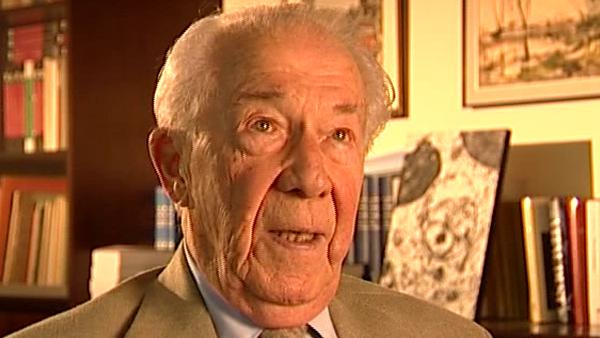NEXT STORY

Working at Theorell's lab
RELATED STORIES

NEXT STORY

Working at Theorell's lab
RELATED STORIES


|
Views | Duration | |
|---|---|---|---|
| 11. The physiology lab: Experimenting with insulin | 259 | 03:38 | |
| 12. The Second World War | 277 | 06:24 | |
| 13. Decision to go into research | 234 | 02:00 | |
| 14. Decision to study chemistry | 236 | 02:54 | |
| 15. 'De Duve, chemistry and medicine, that's the science of the... | 224 | 04:21 | |
| 16. Studying chemistry and getting married | 230 | 03:13 | |
| 17. Purifying penicillin | 235 | 05:24 | |
| 18. Sweden, and memories of Hugo Theorell | 212 | 04:39 | |
| 19. Working at Theorell's lab | 195 | 04:26 | |
| 20. Theorell's lab: Carl and Gerty Cori | 197 | 03:31 |


I had a chemical degree but I still had to become a biochemist. I had been to Scandinavia several times before the war, and so I felt that maybe Sweden, which had escaped the war, might be a good place, and of course, Sweden was a wonderful place for biochemistry, and so I decided I would try to get a fellowship to go to Sweden. And I had a small Belgium fellowship and also I'd made a little money with the book that I had written and so I used that to go to Sweden but I had to be accepted, and at first I had tried to get into a lab directed by Hans Von Euler. Hans Von Euler had discovered what we knew, in those days, as DPM, is now known as NAD. And I had a friend in that lab, actually, a Hungarian girl who I had met there before the war and she wrote to me and said no, this lab is passé, you should go and work with Hugo Theorell, he's the coming man, Hugo Theorell. So naively- I've always done naive things in my life, I just wrote to Hugo Theorell, sent him my book and said I want to learn biochemistry, could you accept me in your lab? And strangely enough, he did. And so I got there in 1946, and had a wonderful time. Theorell was a specialist in the biochemistry of haemoproteins, he'd been a pupil of Warburg, Otto Warburg in Berlin where he had started by purifying human myoglobin, or no, myoglobin, animal myoglobin and then back in Stockholm he had went on to purify cytochrome C, purify catolayse, purify peroxidases, so he was really an expert in the purification and study of haemoproteins. When I arrived I said I don't know how to pipette, I cannot measure pH, I've never done anything of that kind. He said that's okay and he gave- he asked his head assistant to take care of me, Akesson was his name. And he really taught me the rudiments of biochemistry; I mean the manipulations of biochemistry. The topic, at that time, had nothing to do with insulin, I said to Theorell, you just give me whatever problem to work on, I need to learn the trade before I go back to my own problem. And so the trade I learnt there was used to purify human myoglobin, so it was a small excursion for me, but anyway I got the crystals, which was important, in Theorell's lab, unless you got pure protein crystals you were a nobody. But I spent 18 months in that lab, and it was a tremendous experience. First of all Theorell himself was a unique personality, he had had polio as a child and so he could hardly walk. He went on crutches all the time and, in fact he walked on his hands better than on his feet and sometimes he would walk on his hands around the lab, singing some opera tune. He was an accomplished violinist and his wife, Margit, who died just a couple of years ago, maybe last year, was a concert pianist and harpsichordist, and so they would play together every day almost and they would invite musicians at their home, so on, so a very interesting background and I've always loved music and so I was very pleased with that.
Belgian biochemist Christian de Duve (1917-2013) was best known for his work on understanding and categorising subcellular organelles. He won the Nobel Prize in Physiology or Medicine in 1974 for his joint discovery of lysosomes, the subcellular organelles that digest macromolecules and deal with ingested bacteria.
Title: Sweden, and memories of Hugo Theorell
Listeners: Peter Newmark
Peter Newmark has recently retired as Editorial Director of BioMed Central Ltd, the Open Access journal publisher. He obtained a D. Phil. from Oxford University and was originally a research biochemist at St Bartholomew's Hospital Medical School in London, but left research to become Biology Editor and then Deputy Editor of the journal Nature. He then became Managing Director of Current Biology Ltd, where he started a series of Current Opinion journals, and was founding Editor of the journal Current Biology. Subsequently he was Editorial Director for Elsevier Science London, before joining BioMed Central Ltd.
Tags: Sweden, 1946, Hans Von Euler, Hugo Theorell, Otto Warburg, Å Åkesson
Duration: 4 minutes, 39 seconds
Date story recorded: September 2005
Date story went live: 24 January 2008